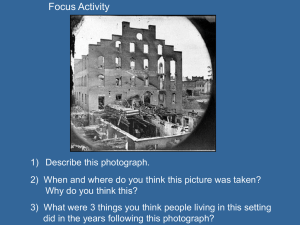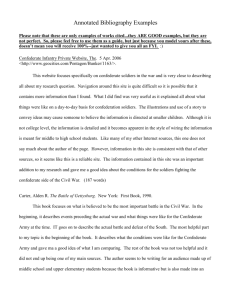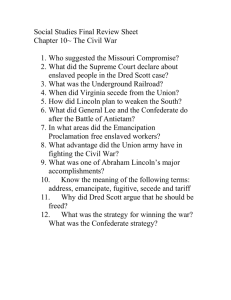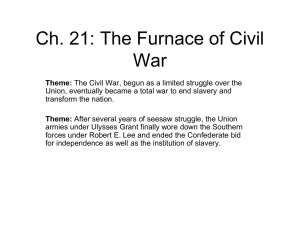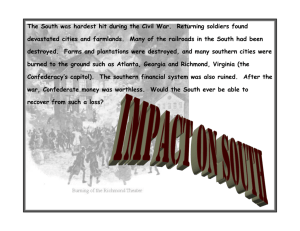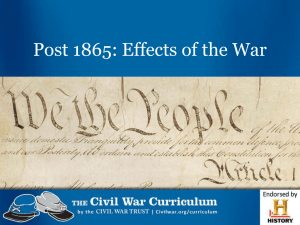vol. xxxvii, no. 2 november 1996
advertisement
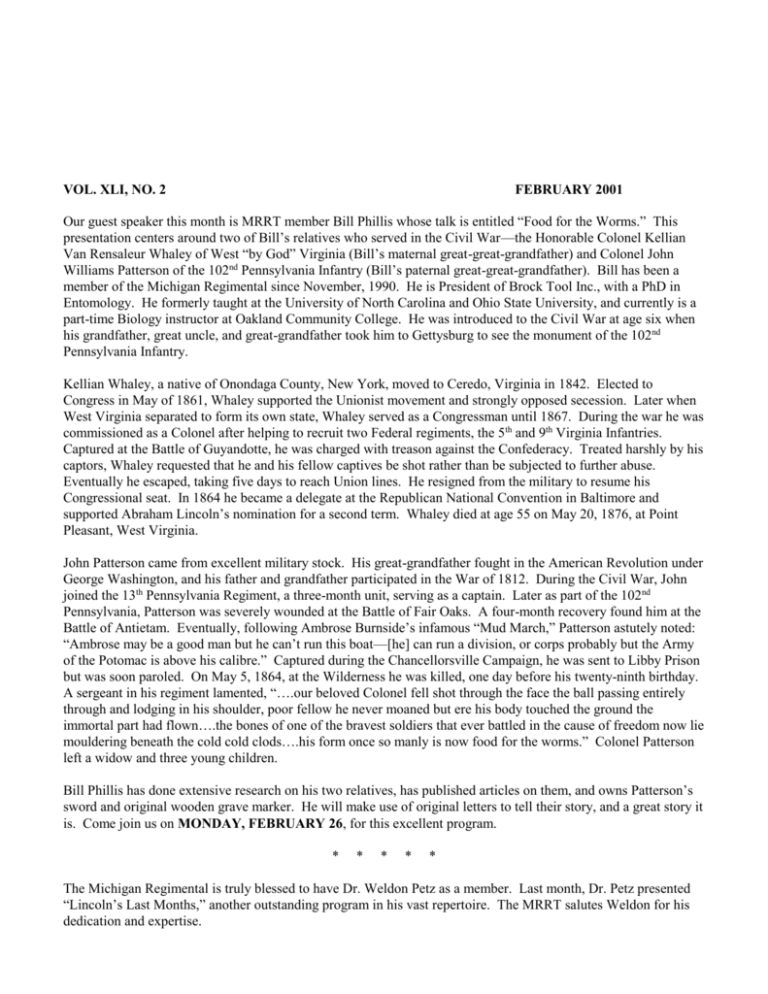
VOL. XLI, NO. 2 FEBRUARY 2001 Our guest speaker this month is MRRT member Bill Phillis whose talk is entitled “Food for the Worms.” This presentation centers around two of Bill’s relatives who served in the Civil War—the Honorable Colonel Kellian Van Rensaleur Whaley of West “by God” Virginia (Bill’s maternal great-great-grandfather) and Colonel John Williams Patterson of the 102nd Pennsylvania Infantry (Bill’s paternal great-great-grandfather). Bill has been a member of the Michigan Regimental since November, 1990. He is President of Brock Tool Inc., with a PhD in Entomology. He formerly taught at the University of North Carolina and Ohio State University, and currently is a part-time Biology instructor at Oakland Community College. He was introduced to the Civil War at age six when his grandfather, great uncle, and great-grandfather took him to Gettysburg to see the monument of the 102nd Pennsylvania Infantry. Kellian Whaley, a native of Onondaga County, New York, moved to Ceredo, Virginia in 1842. Elected to Congress in May of 1861, Whaley supported the Unionist movement and strongly opposed secession. Later when West Virginia separated to form its own state, Whaley served as a Congressman until 1867. During the war he was commissioned as a Colonel after helping to recruit two Federal regiments, the 5th and 9th Virginia Infantries. Captured at the Battle of Guyandotte, he was charged with treason against the Confederacy. Treated harshly by his captors, Whaley requested that he and his fellow captives be shot rather than be subjected to further abuse. Eventually he escaped, taking five days to reach Union lines. He resigned from the military to resume his Congressional seat. In 1864 he became a delegate at the Republican National Convention in Baltimore and supported Abraham Lincoln’s nomination for a second term. Whaley died at age 55 on May 20, 1876, at Point Pleasant, West Virginia. John Patterson came from excellent military stock. His great-grandfather fought in the American Revolution under George Washington, and his father and grandfather participated in the War of 1812. During the Civil War, John joined the 13th Pennsylvania Regiment, a three-month unit, serving as a captain. Later as part of the 102nd Pennsylvania, Patterson was severely wounded at the Battle of Fair Oaks. A four-month recovery found him at the Battle of Antietam. Eventually, following Ambrose Burnside’s infamous “Mud March,” Patterson astutely noted: “Ambrose may be a good man but he can’t run this boat—[he] can run a division, or corps probably but the Army of the Potomac is above his calibre.” Captured during the Chancellorsville Campaign, he was sent to Libby Prison but was soon paroled. On May 5, 1864, at the Wilderness he was killed, one day before his twenty-ninth birthday. A sergeant in his regiment lamented, “….our beloved Colonel fell shot through the face the ball passing entirely through and lodging in his shoulder, poor fellow he never moaned but ere his body touched the ground the immortal part had flown….the bones of one of the bravest soldiers that ever battled in the cause of freedom now lie mouldering beneath the cold cold clods….his form once so manly is now food for the worms.” Colonel Patterson left a widow and three young children. Bill Phillis has done extensive research on his two relatives, has published articles on them, and owns Patterson’s sword and original wooden grave marker. He will make use of original letters to tell their story, and a great story it is. Come join us on MONDAY, FEBRUARY 26, for this excellent program. * * * * * The Michigan Regimental is truly blessed to have Dr. Weldon Petz as a member. Last month, Dr. Petz presented “Lincoln’s Last Months,” another outstanding program in his vast repertoire. The MRRT salutes Weldon for his dedication and expertise. Al Oakes announces the “First Annual History and Military Memorabilia Fair” on Sunday, February 25 at the Knights of Columbus Hall in Clawson. The show will feature antique arms, Civil War photographs and books, battlefield finds, antique knives and swords, Indian artifacts, and military field equipment. The Hall is located at 870 N. Main (between 14 Mile and 15 Mile), and the show runs from 9:00 A.M. to 6:00 P.M. Admission is $3.00. * * * * * QUIZ: February was not known as a busy month during the Civil War, but certain events of importance occurred. Identify the following: 1. What state became the seventh (and last before Lincoln’s inauguration) to secede by a vote of 166-7 on February 1, 1861? And, what noted person from this state became an outcast for speaking out against it? 2. On February 8, 1861, the Confederacy adopted its Constitution. In what two ways did it differ from the U.S. Constitution as far as the Presidency is concerned? 3. On February 3, 1862, President Lincoln declined an offer from a foreign head of state for a type of animal to be used in the war. What were the animals and who offered them? 4. On February 6, 1862, Ulysses S. Grant made headlines by capturing a weakened Confederate fort. Name the fort and the Confederate general who surrendered it to Grant. 5. The Federal VI Corps received a new commander to succeed General William F. Smith on February 4, 1863. Name this noted Union general and where was he killed a little more than a year later on May 9, 1864? 6. On February 23, 1863, President Lincoln accepted the resignation of his minister to Russia. Name this man and the former cabinet post he held. 7. On February 24, 1864, Jefferson Davis promoted an unpopular general to Commander-in-Chief of the Confederate army. Who did he promote and which Confederate general stated that it would be “rewarding failure”? 8. On February 29, 1864, Lincoln approved the revival of which rank in the Federal army to confer on U.S. Grant? And, which aging officer had earlier held this title as a brevet rank? 9. Confederate General John Pegram was killed on February 6, 1865. His younger brother, Willie, was killed a few weeks later on April 1. Name the two battles where the Pegram brothers died. 10. On February 22, 1865, a seceded Confederate state voted to ratify the Thirteenth Amendment abolishing slavery. On the same day a non-seceding slave state voted against ratification. Name the two states. * * * * * Since the Medal of Honor was first authorized as our most prestigious honor for battle on December 31, 1861, some 3412 have been awarded. Of those, 1527 went to Union personnel of the Civil War. Most people are, however, unaware that the Confederacy had its own Medal of Honor. A resolution was passed in the Confederate Congress and signed into law by Jefferson Davis on October 13, 1862, for the enactment of this award, and a flood of names soon poured into Richmond for such recognition. Robert E. Lee openly frowned on the new policy, stating that it would “reward a few and leave many, equally brave and equally faithful, unnoticed….” Others, such as Secretary of War George Randolph, suggested that a shortage of bronze might hinder the project. The Confederate government tabled the issue for nearly a year when it decided instead to inscribe the worthy names on a “Roll of Honor.” More than 2000 names would eventually be recorded. Over 100 years later, on August 16, 1968, the Sons of Confederate Veterans passed a resolution to reinstate the Confederate Medal of Honor. Further bickering established the criteria for such an award—the first of which was given in 1977. Although the “Roll of Honor” contained more than 2000 names, only 42 have been posthumous recipients of the Confederate Medal of Honor. The following is one of their stories. David Herbert Llewellyn knew at an early age that he wanted to become a physician. Growing up in England, he decided to follow in the footsteps of his two older brothers and entered Marlborough College. After graduation he worked under the tutelage of a local doctor for three years before gaining admission to the Charing Cross Hospital Medical School. Finally in 1859, at the age of 22, he passed his qualifications to practice medicine. Sometime after the Civil War broke out in the United States, Dr. Llewellyn volunteered as a ship’s surgeon. No one appears to know why he favored the Confederacy, but the young physician ultimately ended up aboard the C.S.S. Alabama, commanded by Captain Raphael Semmes. For two years the Alabama sailed the high seas with impunity. With eight guns, and a crew of 120 men and 24 officers, she had compiled an envious record of 66 captures, plaguing enemy shipping from the North Atlantic to the Indian Ocean. All the while Dr. Llewellyn performed his duties. But on the morning of June 19, 1864, a formidable foe, the U.S.S. Kearsarge, offered battle seven miles off the coast of Cherbourg, France. Although Semmes knew the Kearsarge’s 11-inch guns could be devastating at close range, he accepted the challenge. When the Alabama came within a mile of the Federal ship, Semmes ordered a blast from the 100-pounder on the starboard bow. The Kearsarge responded with a blast of her own, and the historic fight began. The opposing vessels closed in on one another with a heavy, continuous firing of shells. Dr. Llewellyn set up an operating table in the ward room and diligently attended the wounded. He did not shirk from his duty, but he shuddered somewhat when he felt the cold shock of sea water swirling around his feet. Truly, the 11-inch shells of the Federal ship had ripped jagged holes near the water line of the Alabama, and the sea gushed in on the below decks. When ordered by one of the ship’s officers to exit the flooding ward room, the doctor calmly shook his head and replied, “I must wait for orders, you know.” One shell crashed through the ship, smashing into the ward room, killing one patient, and wrecking the operating table. Dr. Llewellyn miraculously remained unhurt. More damage to the vessel and Semmes was told his ship had “perhaps ten minutes” of life before sinking. Crew members were ordered to abandon ship. The doctor helped numerous men into the lifeboats, but he refused to climb aboard, stating, “I will not peril the wounded men.” Within minutes the Alabama rose at the bow, her stern first to plunge beneath the waves. Many men leaped into the cold water seeking anything to keep themselves afloat. Confederate Executive Officer John McIntosh Kell remembered the hideous scene as “a mass of living heads, striving, struggling, battling for life” in the icy waters. The 26-year-old British doctor had remained behind until he finally leaped into the English Channel. He had told no one that he could not swim. Eight days later students and faculty at Charing Cross Hospital Medical School resolved to erect a memorial to Dr. Llewellyn’s memory. Today a memorial tablet to Dr. David Herbert Llewellyn can be viewed in the main hall of the Medical School. His Medal of Honor is preserved in the custody of the Confederate High Command, a Confederate heritage group headquartered in the United Kingdom. The doctor’s last known letter to a friend included, “If I die, give my best love to all who knew me.” QUIZ ANSWERS: 1. Texas and Sam Houston 3. War elephants and the King of Siam 5. John Sedgwick and Spotsylvania 7. Braxton Bragg and James Longstreet 9. Hatcher’s Run and Five Forks 2. A 6-year term with no re-election 4. Fort Henry and Gen. Lloyd Tilghman 6. Simon Cameron and Sec. of War 8. Lieutenant General and Winfield Scott 10. Tennessee and Kentucky Plan on being at the old Farmington Public Library on Liberty Street (SW of Grand River and Farmington Road) on MONDAY, FEBRUARY 26, for Bill Phillis’ presentation of “Food for the Worms.” The business meeting starts at 7:30 P.M. Be there early to enjoy the fellowship.
